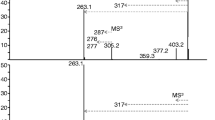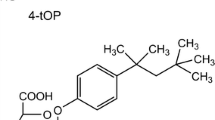Abstract
A method is described for the assay of phenobarbital N-glucosylation using UDP-D-[6-3H)glucose. The radioactive phenobarbital N-glucoside conjugates [(5/R)-PBG, (5S)-PBG] formed during the incubations were resolved from each other and from uncharacterized radioactive products by semipreparative HPLC. The product ratio of the N-glucosides of (5R)-PBG/(5S)-PBG was 2.9 for the crude liver homogenate and 3.0 ± 0.5 for the microsomes. Magnesium was necessary for optimal activity. The K m values for formation of (5R)-PBG, (5S)-PBG, and (5R + 5S)-PBG were 1.55 ± 0.35, 1.27 ± 0.14, and 1.47 ± 0.21 mM, respectively. The Vmax values for formation of (5R)-PBG, (5S)-PBG, and (5R + 5S)-PBG were 1.34 ± 0.05 × 10−6, 0.43 ± 0.01 × 10−6, and 1.77 ± 0.04 × 10−6 µmol/min/mg microso-mal protein, respectively. It was observed that at concentrations greater than 5 mM sodium phenobarbital, inhibition of formation of phenobarbital N-glucosides occurred. The product ratio of (5R)-PBG/(5S)-PBG is comparable to that observed in the urinary excretion studies with the mouse and opposite to that observed in urinary excretion studies in humans.
Similar content being viewed by others
REFERENCES
B. K. Tang, W. Kalow, and A. A. Grey. Metabolic fate of phenobarbital in man: N-Glucoside formation. Drug Metab. Disp. 7:315–318 (1979).
D. Kadar, B. K. Tang, and A. W. Conn. The fate of phenobarbitone in children in hypothermia and at normal body temperature. Can. Anaesth. Soc. J. 29:16–23 (1982).
W. H. Soine, V. O. Bhargava, and L. K. Garrettson. Direct detection of l-(β-D-glucopyranosyl)phenobarbital in human urine. Drug Metab. Disp. 12:792–794 (1984).
W. H. Soine, P. J. Soine, T. M. England, J. W. Ferkany, and B. E. Agriesti. Identification of phenobarbital N-glucosides as urinary metabolites of phenobarbital in mice. J. Pharm. Sci. 80:99–103 (1991).
W. H. Soine, P. J. Soine, S. E. Mongrain, and T. M. England. Stereochemical characterization of the diastereomers of the phenobarbital N-β-D-glucose conjugate excreted in human urine. Pharm. Res. 7:402–406 (1990).
W. H. Soine, P. J. Soine, T. M. England, D. F. Welty, and J. H. Wood. LC determination of the diastereomers of 1-(β-D-glucopyranosyl)phenobarbital in human urine. J. Pharm. Biomed. Anal. 8:365–372 (1990).
W. H. Soine, P. J. Soine, T. M. England, B. M. Overton, and S. Merat. Synthesis of N-β-D-glucopyranosyl derivatives of barbital, phenobarbital, metharbital and mephobarbital. Carbohydr. Res. 193:105–113 (1989).
T. Gessner, A. Jacknowitz, and C. A. Vollmer. Studies of mammalian glucoside conjugation. Biochem. J. 132:249–258 (1973).
R. C. Duggleby. A nonlinear regression program for small computers. Anal. Biochem. 110:9–18 (1981).
B. K. Tang and G. Carro-Ciampi. A method for the study of N-glucosidation in vitro—Amobarbital-N-glucoside formation in incubations with human liver. Biochem. Pharmacol. 29:2085–2088 (1980).
G. Carro-Ciampi, M. Jurima, D. Kadar, B. K. Tang, and W. Kalow. N-Glucosidation of amobarbital in the cat. Can. J. Physiol. Pharmacol. 63:1263–1266 (1985).
S. E. Mongrain and W. H. Soine. Product enantioselectivity in the N-glucosylation of amobarbital by cats. Drug Metab. Disp. 19;1012–1013 (1991).
S. K. Bansal and T. Gessner. A unified method for the assay of uridine diphosphoglucuronyltransferase activities toward various aglycones using uridine diphospho[U-14C]glucuronic acid. Anal. Biochem. 109:321–329 (1980).
N. Arima. Acyl glucuronidation and glucosidation of pranoprofen, a 2-arylpropionic acid derivative, in mouse liver and kidney homogenates. J. Pharmacobio-Dyn. 13:724–732 (1990).
R. S. Labow and D. S. Layne. The formation of glucosides of isoflavones and of some other phenols by rabbit liver microsomal fractions. Biochem. J. 128:491–497 (1972).
N. Arima. Stereoselective acyl glucuronidation and glucosidation of pranoprofen, a 2-arylpropionic acid derivative, in mice in vivo. J. Pharmacobio-Dyn. 13:733–738 (1990).
H. J. Fromm. Initial Rate Enzyme Kinetics, Springer-Verlag, New York, 1975.
Author information
Authors and Affiliations
Rights and permissions
About this article
Cite this article
Soine, W.H., Safi, H. & Westkaemper, R.B. Initial Studies on the N-Glucosylation of Phenobarbital by Mouse Liver Microsomes Using a Radiochemical High-Performance Liquid Chromatographic (HPLC) Method. Pharm Res 9, 613–616 (1992). https://doi.org/10.1023/A:1015889707922
Issue Date:
DOI: https://doi.org/10.1023/A:1015889707922




